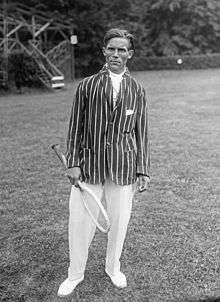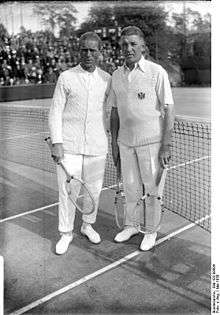Karel Koželuh
Karel Koželuh (Czech: [ˈkarɛl ˈkoʒɛlux]; Hungarian: Kozeluh Károly [ˈkozɛluh ˈkaːroj];[2] 7 March 1895 – 27 April 1950) was a top Czech tennis, association football, and ice hockey player of the 1920s and 1930s. Koželuh never played in the major tournaments of amateur tennis but was an all-around athlete at the highest level.
 Koželuh in 1919 | |
| Country (sports) | |
|---|---|
| Born | 7 March 1895 Prague, Austria-Hungary |
| Died | 27 April 1950 (aged 55) Prague, Czechoslovakia |
| Height | 1.73 m (5 ft 8 in) |
| Plays | Right-handed |
| Int. Tennis HoF | 2006 (member page) |
| Singles | |
| Highest ranking | No. 1 (1930, Pro - American Lawn Tennis magazine)[1] |
| Professional majors | |
| US Pro | W (1929, 1932, 1937) |
| French Pro | W (1930) |

Rugby, football and ice hockey years
Koželuh was born in Prague, Austria-Hungary (today's Prague, Czech Republic), one of seven brothers (and two sisters). His sports career began with rugby and it was only at the age of 16 that he learned to play tennis. In 1914 he joined the strong soccer team of Sparta Prague. In later years Koželuh also played for DFC Prag (Prague) and Teplitzer FK (Teplice).
He played international football for both Austria and Czechoslovakia.[3]
In 1925, he was a member of the Czechoslovakia ice hockey team that won the European Championship, scoring the winning goal in the final game.
Tennis
Early years
He became a professional tennis coach at a fairly young age and thereby made himself ineligible to play in any amateur tournaments. 1912 he beats Roman Najuch in the Germany Pro Championships in Wiesbaden. He did, however, compete in the very few professional tournaments that took place in Europe in the 1920s, contested primarily between teaching professionals. He became known in these tournaments for his speed, his endurance, and his fine groundstrokes from the baseline. He was 5 feet 8 inches tall and weighed 145 pounds. The American tennis player Vinnie Richards said he was "seamy-faced, cadaverous-looking and, in general, resembled a cigar-store Indian." Koželuh used the Continental grip, in which both the forehand and backhand are hit with the same grip, and preferred to play as much as 10 feet behind the baseline, returning balls endlessly to the other court, almost never advancing to the net. Seldom hitting the ball very hard, he was content to outrun and outlast his opponents in exhausting matches of attrition. He won the most prestigious of these European tournaments, the Bristol Cup, played in Beaulieu, France, six times.
Professional years
When a true professional tour was at last started, Koželuh was one of the first players to join it, being signed up for it by Vinnie Richards, who made a special trip to Europe for that sole purpose. In the years to come Koželuh would achieve much greater prominence as a pro than as an amateur. In 1928, his first year as a professional, he beat Richards 15 matches to 5, at a time when Richards was generally considered to be one of the 5 or 6 best players in the world, amateur or professional. In the following years Koželuh continued to dominate Richards, in 1929 beating him 5 times to 2 and in 1930 4 times to 2. After watching one of their lengthy matches, a tennis expert of the time, J. Parmly Paret, wrote in American Lawn Tennis, that Koželuh had "the most perfect defense that I have seen.... But defense alone does not make a champion." He went on to say that either Henri Cochet or Bill Tilden at their best would be able to defeat Koželuh by attacking him consistently from the net. Koželuh defended his somewhat tedious baseline style by saying: "Why should I change my style when it is so successful?"[4]
"Big" Bill Tilden, the greatest player of the 1920s, and by far the most famous, turned professional at the end of 1930 and organized a tour with several lesser players and with himself to play the headline match against Koželuh. Their first encounter was on 18 February 1931 before 14,000 spectators in Madison Square Garden in New York. Tilden won 3 straight sets in only 65 minutes, attacking from both the baseline and the net and overwhelming Koželuh with his power. Tilden won the next 8 matches as well, all of them played indoors on a canvas surface that seldom had enough room for Koželuh to play his normal game far behind the baseline. Koželuh finally won their 10th match on an outdoor concrete court at the Los Angeles Tennis Club. In the course of the year, both in the United States and in Europe, the Czech eventually beat Tilden 17 times while losing 50 matches to him. Koželuh had firmly established himself as one of the half-dozen best players in the world.
Koželuh had already beaten Vinnie Richards to win the United States Pro Championship in 1929. He went on to win the title again in 1932, defeating the German Hans Nüsslein, and in October 1937,[5] beating the American Bruce Barnes at The Greenbrier in West Virginia at the age of 42. With this win, he became the oldest winner of a major professional singles tournament. In the first round at the Greenbrier tournament in 1938 (not classed as the US Pro this year), Koželuh faced Greenbrier golf professional Sam Snead, beating him in three straight sets.[6] Koželuh was the losing finalist at the US Pro in 1928, 1930, 1934 and 1935. Koželuh was a six-time winner of the Bristol Cup (Menton, France), which was the most prestigious professional title in the world in the 1920s. He also won the World Pro tournament in Deauville, France, in 1925. Another major title for Koželuh was the French Professional Championship of 1930.
He is not to be confused with another fine Czech tennis player of the same era, Jan Koželuh, who was Karel's younger brother. Jan was good enough to be ranked as high as the World No. 10 amateur in 1927.[7]
Koželuh was inducted into the International Tennis Hall of Fame in Newport, Rhode Island, in 2006.
Major finals
Pro Slam tournaments
Singles: 8 (4 titles, 4 runners-up)
| Result | Year | Championship | Surface | Opponent | Score |
|---|---|---|---|---|---|
| Loss | 1928 | U.S. Pro | Grass | 6–8, 3–6, 6–0, 2–6 | |
| Win | 1929 | U.S. Pro | Grass | 6–4, 6–4, 4–6, 4–6, 7–5 | |
| Win | 1930 | French Pro | Clay | 6–1, 6–2, 6–1 | |
| Loss | 1930 | U.S. Pro | Grass | 2–6, 10–8, 6–3, 6–4 | |
| Win | 1932 | U.S. Pro | Clay | 6–2, 6–3, 7–5 | |
| Loss | 1934 | U.S. Pro | Clay | 4–6, 2–6, 6–1, 5–7 | |
| Loss | 1935 | U.S. Pro | Clay | 0–6, 6–1, 6–4, 0–6, 6–4 | |
| Win | 1937 | U.S. Pro | Clay | 6–2, 6–3, 4–6, 4–6, 6–1 |
Notes
- K. De Lang, ed. (14 January 1930). "Lawntennis" (PDF). Het Vaderland (in Dutch). Beetsterzwaag, Netherlands: C.M. Schilt. 61: 15. Retrieved 5 July 2013.
- Béla Kehrling, ed. (25 October 1929). "Külföldi hírek" [International news] (PDF). Tennisz és Golf (in Hungarian). Budapest, Hungary: Egyesült Kő-, Könyvnyomda. Könyv- és Lapkiadó Rt. I (12): 293. Retrieved 15 July 2013.
- "Players Appearing for Two or More Countries". RSSSF. Archived from the original on 3 August 2008. Retrieved 9 July 2014.
- The History of Professional Tennis, Joe McCauley (2003) Much of the above information relating to Vinnie Richards comes from McCauley's book.
- "History of the Pro Tennis Wars, Chapter VIII: 1937". Retrieved 15 October 2019.
- The Boston Globe, 26 April 1938
- "Causa". Reflex (in Czech). 2006. Archived from the original on 12 February 2007.
Sources
- The History of Professional Tennis, Joe McCauley (2003)
External links
- Karel Koželuh at FAČR (in Czech)

- History of the Pro Tennis Wars
- Karel Koželuh at the International Tennis Hall of Fame
- Biographical information and career statistics from Eliteprospects.com